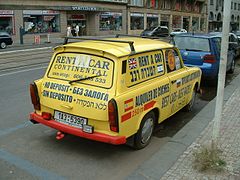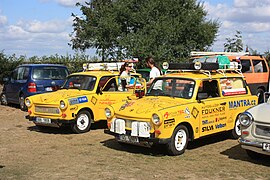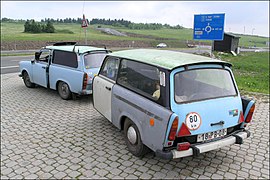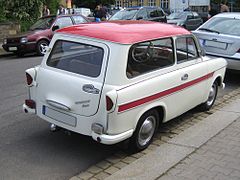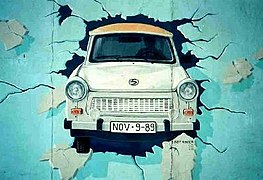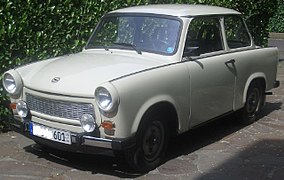Trabant
| Trabant | |
|---|---|
| Overview | |
| Manufacturer | VEB Sachsenring |
| Production |
|
| Body and chassis | |
| Body style |
|
| Layout | Transverse front-engine, front-wheel-drive |
| Powertrain | |
| Engine |
|
| Dimensions | |
| Wheelbase | 2,020 mm (79.5 in)[1] |
| Length | 3,360 mm (132.3 in)[1] |
| Width | 1,500 mm (59.06 in)[2] |
Trabant(German:[tʁaˈbant]) is a series ofsmall carsproduced from 1957 until 1991 by formerEast Germancar manufacturerVEB Sachsenring Automobilwerke Zwickau.Four models were made: theTrabant 500,Trabant 600,Trabant 601,and theTrabant 1.1.The first model, the 500, was a relatively modern car when it was introduced.
It featured detachableduroplastbody panels on a galvanised steel unibody chassis, front-wheel drive, a transverse two-stroke engine, and independent suspension. Because this 1950s design remained largely unchanged until the introduction of the last model, theTrabant 1.1in 1990, the Trabant became symbolic of the former East Germany's stagnant economy and the collapse of theEastern Blocin general.[3]Called "a spark plug with a roof", 3,096,999 Trabants were produced.[4]Older models have been sought by collectors in the United States due to their low cost and fewer restrictions on the importation ofantique cars.The Trabant also gained a following amongcar tuningandrallyingenthusiasts.
Overview
[edit]

TheGermanwordTrabant,derived fromMiddle High Germandrabant,means 'satellite' or 'companion'.[a]The car's name was inspired by the SovietSputniksatellite.[6][7]The cars are often referred to as "Trabbi" or "Trabi". Produced without major changes for nearly 30 years, the Trabant became the most common automobile in East Germany. It came to symbolize the country during thefall of the Berlin Wallin 1989, as images of East Germans crossing the border intoWest Germanywere broadcast around the globe.[8][9]
Manufactured by astate monopoly,a Trabant took about ten years to acquire.[10]East German buyers were placed on a waiting-list of up to thirteen years.[11]The waiting time depended on their proximity toBerlin,the capital.[6]Officialstatepricewas 7,450GDR marksand the demand to production ratio was forty three to one (1989). Thefree marketprice for a second-hand one was more than twice the price of a new one, and the average worker had to wait ten to thirteen years on a waiting list, or, if available, pay more than double for a second hand model.[11]
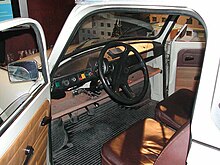
The Trabant had a steel frame, with the roof, boot lid, bonnet, wings and doors made ofduroplast,a hardplasticmade fromrecycled cottonwaste from the Soviet Union and phenol resins from the East German dye industry.[6][12]It was the second car with a body made of recycled material; the first was theAWZ P70 Zwickau,produced from 1955 to 1959. The material was durable, and the average lifespan of a Trabant was 28 years.[12]
The Trabant's build quality was poor, and it was loud, slow, and poorly designed.[11][13][3]
The car had four principal variants:
- TheTrabant P 50,also known as the Trabant 500 (produced 1957–1962)
- TheTrabant 600(1962–1965)
- TheTrabant 601(1964–1990)
- TheTrabant 1.1,produced in 1990–1991 with a 1,043cc(63.6cu in) VW engine
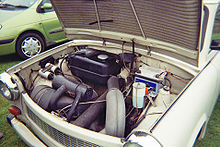
The engine for the 500, 600 and the original 601 was a smalltwo-stroke enginewith two cylinders, accounting for the vehicle's modest performance. Itscurb weightwas about 600 kg (1,323 lb). When it ceased production in 1989, the Trabant delivered 26 PS (19 kW)[14]from 594 cc (36.2 cu in)displacement. It took 21 seconds to accelerate from zero to its top speed of 100 km/h (62 mph).[15][16]
The engine produced a very smoky exhaust and was a significant source ofair pollution:nine times the hydrocarbons and five times the carbon-monoxide emissions of the average 2007 European car. Its fuel consumption was 7 L/100 km (40 mpg‑imp;34 mpg‑US).[17]Since the engine wastwo-stroke,oil had to be added to the 24-liter (6.3 U.S. gal; 5.3 imp gal) fuel tank[18]at a 50:1 (or 33:1) ratio of fuel to oil at each fill-up. Contemporary gas stations in countries where two-stroke engines were common sold a premixed gas-oil mixture at the pump. Because the Trabant had nofuel pump,its fuel tank was above the motor so fuel could reach the carburettor by gravity; this increased the risk of fire in front-end accidents. Earlier models had no fuel gauge, and a dipstick was inserted into the tank to determine how much fuel remained.
Known for its dull colour scheme and cramped, uncomfortable ride, the Trabant is an object of ridicule for many Germans and is regarded as symbolic of the fall of theEastern Bloc.[19]Known as a "spark plug with a roof" because of its small size, the car did gain public affection.[8][9]
Its design remained essentially unchanged from its introduction in the late 1950s, and the last model was introduced in 1990. The 1980s model had notachometer,no indicator for either the headlights or turn signals, no fuel gauge, no rear seat belts, no external fuel door, and drivers had to pour a mix of gasoline and oil directly under the bonnet/hood.[20]In contrast, the West GermanVolkswagen Beetlereceived a number of updates (including improvements in efficiency) over a similar period.[21]
History
[edit]Origins
[edit]VEB Sachsenring Automobilwerke Zwickau had its origins in the formerAuto Union/DKWbusiness which had operated out of the site prior to the war, and the company's first products were essentially copies of pre-war DKW designs. Following the partition of Germany, Auto Union re-established itself inWest Germany(ultimately evolving intoAudi), leaving VEB Sachsenring with the two stroke engine inherited from DKW.
The Trabant was the result of a planning process which had been intended to design a three-wheeled motorcycle.[6]In German,Trabantis an astronomical term for a moon (or other natural satellite) of a celestial body.[22]
Full production
[edit]
The first of the Trabants left the VEB Sachsenring Automobilwerke Zwickau factory in Saxony on 7 November 1957. It was a relatively advanced car when it was formally introduced the following year, withfront wheel drive,unitary constructionand independent suspension. The Trabant's greatest shortcoming was its engine. By the late 1950s, many small West European cars (such as theRenault) had cleaner, more-efficientfour-strokeengines, but budgetary constraints and raw-materials shortages mandated an outdated (but inexpensive) two-stroke engine in the Trabant. It was technically equivalent to the West GermanLloydautomobile, a similarly sized car with an air-cooled, two-cylinder four-stroke engine. The Trabant had a front,transversely mountedengine andfront-wheel drivein an era when many European cars were using rear-mounted engines or front-mounted engines with rear-wheel drive. Its greatest drawback was its largely unchanged production; the car's two-stroke engine made it obsolete by the 1970s, limiting exports to Western Europe.
The Trabant's air-cooled, 500 cc (31 cu in) engine—upgraded to 600 cc (37 cu in) in 1962–63—was derived from a pre-warDKWdesign with minor alterations during its production run. The firstSaabcar had a larger (764 cc), water-cooled, two-cylinder two-stroke engine.Wartburg,an East German manufacturer of larger sedans, also used a water-cooled, three-cylinder, 1,000cc(61cu in), two-stroke DKW engine.
The original Trabant, introduced in 1958, was theP 50.Trabant's base model, it shared a large number of interchangeable parts with the latest 1.1s. The 500 cc, 17 PS (13 kW) P50 evolved into a 20 PS (15 kW) version with a fully synchronized gearbox in 1960, and received a 23 PS (17 kW), 600 cc (37 cu in) engine in 1962 as the P 60.

The updated P601 was introduced in 1964. It was essentially a facelift of the P 60, with a different front fascia, bonnet, roof and rear and the original P50 underpinnings. The model remained nearly unchanged until the end of its production except for the addition of 12V electricity, rear coil springs and an updated dashboard for later models.

The Trabant's designers expected production to extend until 1967 at the latest, and East German designers and engineers created a series of more-sophisticated prototypes intended to replace the P601; several are displayed at theDresden Transport Museum.Each proposal for a new model was rejected by the East German government due to shortages of the raw materials required in larger quantities for the more-advanced designs. As a result, the Trabant remained largely unchanged for more than a quarter-century. Also unchanged was its production method, which was extremely labour-intensive.
Production started from 34,000 p.a. in 1964, reached 100,000 p.a. in 1973, to a high of 150,000 in 1989.[11]
The Trabant 1.1 was a 601 with a better-performing 1.05-liter (64 cu in), 45 PS (33 kW)VW Poloengine. With a slightly modified look (including a floor-mounted gearshift), it was quieter and cleaner than its predecessor. The 1.1 had front disc brakes, and its wheel assembly was borrowed fromVolkswagen.It was produced from 1989 to 1991, in parallel with the two-stroke P601. Except for the engine and transmission, many parts from older P50s, P60s and 601s were compatible with the 1.1.
1989–1991
[edit]

In mid-1989, thousands of East Germans began loading their Trabants with as much as they could carry and drove to Hungary or Czechoslovakia en route to West Germany–the so-called "Trabi Trail". Many had to get special permission to drive their Trabants into West Germany. The cars did not meet West German emissions standards and polluted the air at four times the European average.[23]
A licensed version of theVolkswagen Poloengine replaced the Trabant's two-stroke engine, the result of a trade agreement between East and West Germany. The first prototypes were built in 1988, with pre-series cars appearing in 1989, but series production only began in May 1990 - By which time the two German states had already agreed toreunification.The locally builtEA111-series enginewas given the model code BM 820 by the East Germans; the plant also made 1.3-liter versions for theWartburg 1.3(BM 860) and theBarkas utility vehicle(BM 880).[24]The model, the Trabant 1.1, also had minor improvements to its brake and signal lights, a renovated grille, andMacPherson strutsinstead of a leaf-spring-suspended chassis.
By April 1991, after only eleven months, the Trabant 1.1 was discontinued. In total, 3.7 million Trabant vehicles had been produced.[25]However, it soon became apparent that there was no place for the Trabant in a reunified German economy. Its inefficient, labour-intensive production line had only survived thanks to government subsidies.
TheZwickaufactory in Mosel (where the Trabant was manufactured) was sold toVolkswagenAG; the rest of the company becameHQM Sachsenring GmbH.Volkswagen redeveloped the Zwickau factory into a centre for engine production; it also produces someVolkswagen GolfsandPassats.
1990s and later
[edit]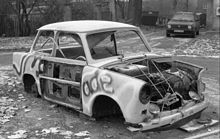
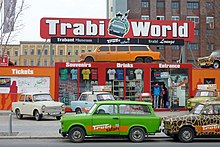
According to Richard Leiby, the Trabant had become "a symbol of the technological and social backwardness of the East German state."[26]Trabants became a symbol of the GDR's serious flaws in the West after the fall of theBerlin Wall,when many were abandoned by their Eastern owners who migrated west. Unlike theLada Niva,Škoda Estelle,Polski Fiat(design licensedfrom the Italian car manufacturer) andYugo,the Trabant had negligible sales in Western Europe.
A Trabant could be bought for as little as a fewDeutsche Marksduring the early 1990s, and many were given away. Although prices recovered as they became collectors' items, they remain inexpensive cars. In herBodyworkproject,performance artistLiz Cohentransformed a 1987 Trabant into a 1973Chevrolet El Camino.[27]The Trabant was planned to return to production inUzbekistanas the Olimp during the late 1990s,[28]but only one model was produced.[29]

Former BulgarianForeign MinisterandAtlantic Club of Bulgariafounding presidentSolomon Passyowned a Trabant which was blessed byPope John Paul IIin 2002 and in which he tookNATO Secretaries GeneralManfred Wörner,George Robertson,andJaap de Hoop Schefferfor rides. In 2005, Passy donated the vehicle (which had become symbolic of Bulgaria's NATO accession) to theNational Historical Museum of Bulgaria.[30]In 1997, the Trabant was celebrated for passing themoose testwithout rolling over, as theMercedes-Benz W168had; aThuringiannewspaper's headline read, "Come and get us, moose! Trabi passes A-Class killer test".[31]
The Trabant entered the world ofdiplomacyin 2007 when Steven Fisher,deputy head of missionat the BritishEmbassyinBudapest,used a 1.1 (painted as close toBritish racing greenas possible) as hisdiplomatic car.[32][33]American Trabant owners celebrate the fall of the Berlin Wall with the Parade of Trabants, an annual early-November rally held inWashington, D.C.The event, sponsored by the privately ownedInternational Spy Museum,includes street tours in Trabants, rides, live German music and displays about East Germany.[34]
Planned reintroduction
[edit]TheHerpacompany, aBavarianminiature-vehicle manufacturer, bought the rights to the Trabant name and showed a scale model of a "newTrabi" at the2007 Frankfurt Motor Show.Plans for production included a limited run, possibly with a BMW engine.[8][9][35]A Trabant nT model was unveiled two years later in Frankfurt.[36]
The Trabant nTconsortiumincludes Herpa, the German specialized-auto-parts manufacturer IndiKar and the German automobile-engineering companyIAV.[37]The group was looking for investment, design and production in the Trabant's original hometown of Zwickau,[38]with sales "in 2012".[39]The Trabant nTelectric carwould be equipped with a 45 kW (60 hp; 61 PS)asynchronous motorpowered by alithium-ion battery.[40]
Models
[edit]

- P50: Later known as the 500 (Limousine and Universal [Combi])
- 600 (Limousine and Universal)
- 601 Standard (Limousine, Universal)
- 601S (Sonderwunsch;Special Edition) with fog lamps, a rear white light and an odometer
- 601 DeLuxe: Similar to the 601S, with two colours and a chrome bumper
- 601 Kübel: Doorless jeep with a folding roof, auxiliary heating system and RFI-shielded ignition
- 601 Tramp: Civilian version of the Kübel, primarily exported to Greece
- 601 Hycomat: For drivers unable to use their left leg, with anautomatic clutch
- 800RS: Rally version
- 1.1: Limousine, Universal and Tramp (convertible)
Prototype and concepts
[edit]Dozens of prototypes have been created over the years that have not gone into mass production.
- 1954 Trabant P50 prototype[41]
- 1954 Trabant P50 Universal prototype
- 1959 Trabant P504
- 1961 Trabant P100
- 1965 Trabant P602V
- 1970 Trabant P760
- 1971 Trabant P610 Prototype
- 1981 Trabant P601 Z
- 1982 Trabant 601 WE II Prototype[42]
- 1988 Trabant 1.1 E
- 2009 Trabant nT Concept
Gallery prototypes
[edit]-
Trabant P 50
-
Trabant P 1.1 Kubelwagen
-
Trabant P 601 WE II
-
Trabant 500 Pickup
-
Trabant P 50 Kombi
-
Trabant nT
Gallery
[edit]-
A "billboard on wheels" inPrague
-
Outfitted for volunteer firefighting
-
Police car used for public relations inBremen
-
Leaving for a 2009 trip from Prague toCape Town
-
601 with homemade trailer
-
600 universal
-
Graffiti of a Trabant driving through the Berlin Wall
-
601S universal, with sliding roof
-
601 Deluxe limousine
-
601 Kübel
-
1.1 universal
-
Trabants in an East Berlin, East Germany parking lot during the freedom summer of 1990 (between the fall of The Wall and German Reunification)
-
Trabant registeredMonte Carlo(av.Grimaldi-2023)
See also
[edit]- August Horch Museum Zwickau
- Jokes about the Trabant
- List of automobiles known for negative reception
- Ostalgie
- Soybean car
- Yugo
Notes
[edit]- ^According toElof Hellquist'sSvensk etymologisk ordbok(SwedishEtymological Dictionary,ISBN91-40-01978-0), the word also exists inLow Germandravant,Frenchtrabantand Italiantrabantebut its origin is unknown: "It is not even certain whether the Romance words have been borrowed from the German, or vice versa."[5]
References
[edit]- ^abLegends of the Open Road.Rizzoli International Publications. 2007.ISBN978-88-6130-066-8.
- ^World Cars 1978.Herald Books. 1978.ISBN0-910714-10-X.
- ^abDe Muro, Doug (November 2016)."The Trabant Was an Awful Car Made by Communists".Autotrader.com.Retrieved17 November2018.
- ^Williams, Adam (6 September 2007)."Boxy East German icon plans comeback".Reuters.Retrieved13 May2020.
- ^"99 (Svensk etymologisk ordbok)".runeberg.org(in Swedish). 1922.Archivedfrom the original on 7 November 2017.Retrieved28 February2017.(in Swedish)
- ^abcdJames, Kyle (19 May 2007)."Go, Trabi, Go! East Germany's Darling Car Turns 50".Deutsche Welle.Archivedfrom the original on 11 September 2007.
- ^Stokes, Raymond G. (2000). "Plastics and the New Society: The German Democratic Republic in the 1950s and 1960s". In Reid, Susan E.; Crowley, David (eds.).Style and Socialism: Modernity and Material Culture in Post-War Eastern Europe.Oxford, U.K.; New York, N.Y.: Berg.ISBN1-85973-239-9.OCLC898724665.
- ^abcWilliams, Adam (6 September 2007)."The 'Trabi' automobile, once a symbol of East Germany, to be revived".International Herald Tribune.Reuters. Archived fromthe originalon 4 December 2008.Retrieved17 September2011.
- ^abc"German Firm Plans to Launch Revamped Trabant".Deutsche Welle. 7 September 2007.Archivedfrom the original on 24 February 2009.Retrieved2 December2010.
- ^"The 12 worst cars ever built".The Globe and Mail.January 2010.Retrieved29 June2019.
- ^abcdRubin, Eli (18 September 2009)."The Trabant: Consumption, Eigen-Sinn, and Movement".History Workshop Journal.68(1): 27–44.doi:10.1093/hwj/dbp016.ISSN1363-3554.
- ^ab"Special From Germany: Show 402".Scientific American Frontiers.PBS. Archived fromthe originalon 3 July 2015.
- ^Cotta, Rick (15 July 2013)."Driving a Trabant".
- ^PS = Pferdestärke = metric horsepower = 0.9863 horsepower (US)
- ^"BBC".BBC. 1 January 2007.Archivedfrom the original on 16 January 2014.Retrieved14 January2014.
- ^"carfolio.com".carfolio.com. 28 February 2013.Archivedfrom the original on 16 January 2014.Retrieved2 May2014.
- ^"Trans National Trabant Tour 2007".Transtrabant.cz. Archived fromthe originalon 18 July 2011.Retrieved2 December2010.
- ^Silk, Bernard (3 May 2003)."Daily Telegraph".Telegraph.London.Archivedfrom the original on 23 October 2011.Retrieved2 December2010.
- ^Hockenos, Paul (7 November 2014)."Berlin Welcomes Back the Trabant, if Only for a Day".The New York Times.Archivedfrom the original on 7 November 2017.
- ^De Muro, Doug (11 August 2016)."The Trabant Was an Awful Car Made by Communists".Autotrader.
- ^Richard Stroup (2003).Eco-nomics: What Everyone Should Know about Economics and the Environment.Cato Institute. p.32.ISBN978-1-930865-44-0.
- ^"Translate Trabant from German to English".www.interglot.com.Archivedfrom the original on 7 October 2017.Retrieved9 May2018.
- ^Sebetsyen, Victor (2009).Revolution 1989: The Fall of the Soviet Empire.New York City:Pantheon Books.ISBN978-0-375-42532-5.
- ^Kirchberg, Peter (2003)."Die Implantation des VW-Motors in den DDR-Automobilbau. Ein Bericht zur Innovationsgeschichte der DDR"[The installation of VW engines in East German cars: An episode in the history of East German innovations](PDF).Dresdener Beiträge zur Geschichte der Technikwissenschaften(in German) (128): 129. Archived fromthe original(PDF)on 20 December 2015.
- ^"Trabant".Archived fromthe originalon 14 April 2011.
- ^Richard A. Leiby (1999).The Unification of Germany, 1989–1990.Greenwood. p.185.ISBN978-0-313-29969-8.
- ^Keats, Jonathon (July 2003)."High-Performance Artist".Wired.Archivedfrom the original on 1 December 2016.Retrieved1 December2016.
- ^"Trabant Clunks Back to Life".Moscowtimes.ru. Archived fromthe originalon 11 February 2008.Retrieved2 December2010.
- ^"Automobile Industry in Uzbekistan".Archivedfrom the original on 3 July 2011.Retrieved2 December2010.
- ^"Соломон Паси подари трабанта си на НИМ"(in Bulgarian). Вести. 13 July 2005.Archivedfrom the original on 18 July 2011.Retrieved13 November2009.
- ^"Petite feat".drive.com.au. 6 May 2005. Archived fromthe originalon 25 March 2012.Retrieved2 December2010.
- ^"British Deputy Ambassador's ride small and green".Politics.Hu. Archived fromthe originalon 21 July 2011.Retrieved28 April2009.
- ^Zsolt, Csikós (10 November 2008)."A brit nagykövethelyettes Trabantja (" The British Deputy Ambassador's Trabant ")".TotalCar.hu Ltd.Archivedfrom the original on 12 August 2011.Retrieved5 October2012.
- ^"14th Annual Parade of Trabants".International Spy Museum.International Spy Museum.7 November 2020.Retrieved15 April2021.
- ^Williams, Adam (6 September 2007)."The 'Trabi' automobile, once a symbol of East Germany, to be revived".The New York Times.Archivedfrom the original on 13 January 2015.Retrieved5 October2012.
- ^"Photo Gallery: Electric Trabant Unveiled at Frankfurt Motor Show".Spiegel Online. 16 September 2009.Archivedfrom the original on 29 March 2014.Retrieved5 October2012.
- ^"German group develops new Trabant".London: news.bbc.co.uk. 14 August 2009.Retrieved14 August2009.
- ^Hall, Allan (14 August 2009)."Smoke-belching Trabant to be reborn as electric car".telegraph.London. Archived fromthe originalon 17 August 2009.Retrieved14 August2009.
- ^"The" newTrabi "idea becomes the" Trabant nT "concept car".Trabant nT GmbH.Archivedfrom the original on 5 September 2012.Retrieved5 October2012.
- ^"Eco Cars: All-electric Trabant NT Gears To Clean 20-year-old Mess".Ecofriend. 17 September 2009. Archived fromthe originalon 23 September 2009.Retrieved14 October2009.
- ^"Trabant-modellen inclusief voorlopers en prototypen paul-wouters.nl/".
- ^"Trabant 601 WE II Prototype 1982 pictures favcars.com".
Further reading
[edit]- Berdahl, Daphne. "'Go, Trabi, Go!': Reflections on a Car and Its Symbolization over Time."Anthropology and Humanism25.2 (2000): 131–141.online
- Rubin, Eli. "The Trabant: Consumption, Eigen-Sinn, and Movement."History Workshop Journal(2009) 68#1 pp 27–44.online
- Zatlin, Jonathan R. "The vehicle of desire: The Trabant, the Wartburg, and the end of the GDR."German History15.3 (1997): 358–380.online
- Lisse, Jürgen (2010),Fahrzeuglexikon Trabant(in German) (2. erweiterte ed.), Witzschdorf: Bildverlag Böttger,ISBN978-3-937496-34-4
- Röcke, Matthias (2011),Die Trabi-Story. Der Dauerbrenner aus Zwickau(in German), Bath: Parragon,ISBN978-1-4454-6266-0,vormals in zwei Auflagen erschienen im Heel Verlag
- Stiegler, Theo (2007),Der Trabant wird 50! In guten wie in schlechten Zeiten(in German), Dresden: edition Sächsische Zeitung/Saxo’Phon,ISBN978-3-938325-36-0
- Sarotte, Mary Elise (2014).The Collapse: The Accidental Opening of the Berlin Wall.New York: Basic Books. p. 291.ISBN978-0-465-06494-6.
External links
[edit]This article'suse ofexternal linksmay not follow Wikipedia's policies or guidelines.(August 2020) |
- UK-based official Wartburg, Trabant and IFA owners' club
- TrabantatCurlie
- TrabantForumsTrabantForums.com
- History of the Trabant
- The story behind Trabant
- Sachsenring Trabant site
- IFA Mobile 2-takt Vereniging, de oudste vereniging voor Oost-Duitse auto's
- Trabant history and prospectsArchived30 January 2009 at theWayback Machine
- Technical Data and additional Information about Trabant 601.Archived19 November 2010 at theWayback Machine
- Technical details and pictures of the Trabant 601
- British microcar club that welcomes trabant owners and drivers
- Trabant – East Germany's Finest
- Media







